Contents


Radish is the most unpretentious and cold-resistant vegetable crop. With the advent of the first radish in spring, our diet is replenished with vitamins, which the body lacks so much after a long winter. Despite the appearance of summer seasonal vegetables, the demand for radishes remains stable throughout the year, which is why many vegetable growers plant them even in winter. In a polycarbonate greenhouse, radishes can be grown all year round, and if you choose the right variety, then a rich and early harvest is guaranteed.
Variety choice
In principle, any variety of radish can be grown in a greenhouse, but since the main goal of each vegetable grower is to obtain a quick and high-quality harvest, early ripening and early varieties should be planted. “Early” means that the radish has a short ripening period, while “early” means that it can be planted in early spring and tolerates low temperatures well.
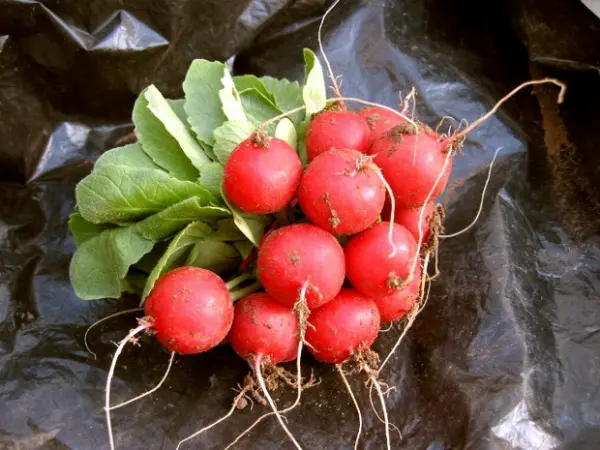
There are many varieties of radishes that combine these qualities:
- “18 days” – the ripening period of the radish really corresponds to the name (18–20 days), the roots of this variety are oblong, red in length, and white at the tip, the flesh is juicy, soft, mild in taste;
- “Pervenets F1” – even, large (30–35 g), round red root crops ripen in 16–18 days, high-yielding variety (3–3,5 kg per 1 m XNUMX), resistant to cracking, juicy pulp, without bitterness ;
- “Children’s F1” – according to the manufacturer’s instructions, the radish of this variety can be harvested after 16 days from emergence, the roots are small (15–20 g), red, the pulp is juicy, slightly sharp;
- “Ultra early red” – the ripening period is 20 days, the roots are red, medium-sized (up to 15 g), the pulp is juicy, almost not sharp, the leaves of this radish are tender and not prickly – they can be used in salads, soups;
- “Heat” – early ripe (20-21 days) radish with bright red root crops, designed specifically for growing in a greenhouse, high-yielding, the flesh is slightly sharp, does not tolerate high temperatures, so the greenhouse needs to be ventilated more often, especially if the structure is made of polycarbonate;
- “Presto” – ultra-early radish, ready for harvesting on the 16th day from germination, root crops are red, beautiful and even, the flesh is white, juicy, the variety is intended for early planting in the greenhouse;
- “French Breakfast” – elongated, raspberry, with white tips, root crops ripen in 20-25 days, the pulp is juicy, soft, mild taste;
- “Celeste F1” is a high-yielding early radish of Dutch selection, ripens in 20–21 days, the roots are even, round, red in color, have a mild taste and excellent presentation.
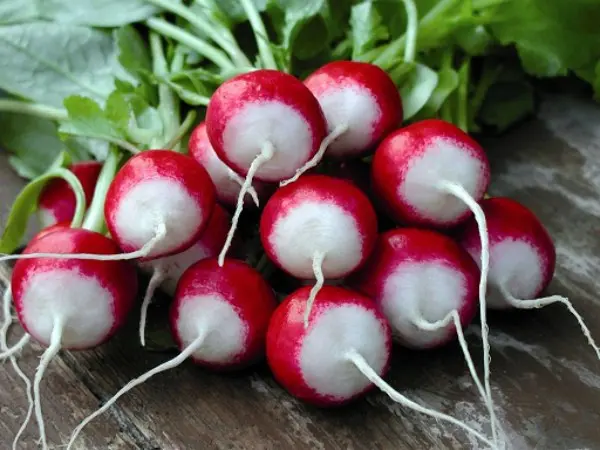
Preparation for sowing
Planting early radishes in a polycarbonate greenhouse requires preliminary preparation of the soil and seed.
The soil should be prepared a couple of months before the seeds are sown. Under the radish, which is planned to be planted in early spring, the soil is prepared in the fall. All plant residues are removed from the future beds, humus or compost is added and dug up.
Radishes prefer well-drained soil with neutral acidity. If the land in your greenhouse does not meet these characteristics, then it needs to be corrected. To improve drainage properties, you can add peat, wood ash, a little river sand, to reduce acidity, add slaked lime or dolomite chips. If vegetables are regularly planted in the greenhouse, the soil does not rest and is quickly depleted. In such a land, before planting a radish, it is necessary to add mineral complex fertilizers containing phosphorus and potassium.
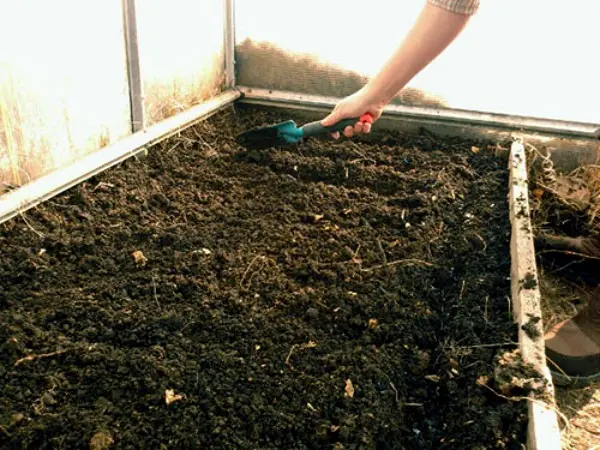
Radish seeds should be planted in warm soil. Shortly before sowing is carried out, the ground is covered with a film. If the radish is planted in a greenhouse in winter, then the best way to warm the soil is to pour hot water on it, then cover it with a film for 2-3 days. In the spring (March-April), there is no need to warm up the soil, since favorable conditions in the greenhouse are created naturally.
When buying radish seeds, choose special varieties for growing in a greenhouse. Despite the fact that store seeds, as a rule, have already been processed, preparation for them will not be superfluous. The material needs to be calibrated – select the largest seeds (3 mm or more), then soak briefly in warm water. If some of the seeds did not sink to the bottom, but floated up, this is a sign that they are empty – sowing is not carried out with such seeds. Those seeds that have sunk to the bottom are placed in a weak solution of potassium permanganate for 20-30 minutes for disinfection, after which they are placed in a damp cloth for a couple of days to germinate.
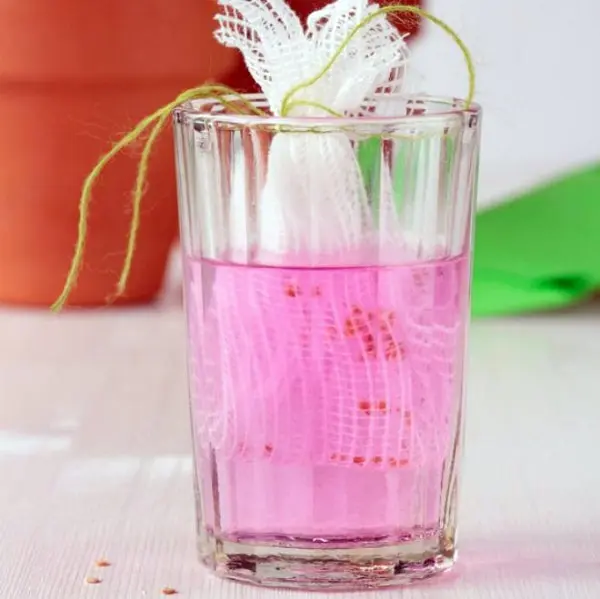
Sowing technology
Sowing radishes in the greenhouse is done manually. On a pre-prepared bed, you need to make shallow (2-3 cm) continuous furrows at a distance of 7-10 cm. Radish loves moisture, so the bottom of each hole should be well watered, and after the moisture is absorbed, sow the seeds. Technically, there are two ways to plant radish seeds:
- Place the seeds at a distance of 3-4 cm in a checkerboard pattern along the entire length of the row. The method, of course, is troublesome, but its advantage is that such a planting will save you from further thinning of radish seedlings.
- Sowing seeds can be done densely, but in this case, the radish will need to be thinned out as soon as the plants have a couple of true leaves. All weak shoots should be removed, leaving the strongest at a distance of 4–5 cm.
No matter how the sowing is carried out, it must be remembered that the radish has a superficial root system, so you need to plant the seeds shallowly – a depth of 1-1,5 cm in the greenhouse will be enough. After sowing the seeds, the bed should be well watered. In the first days after the sowing was done, it is better to maintain the temperature in the greenhouse at +15 ° C, then the seeds will germinate faster.
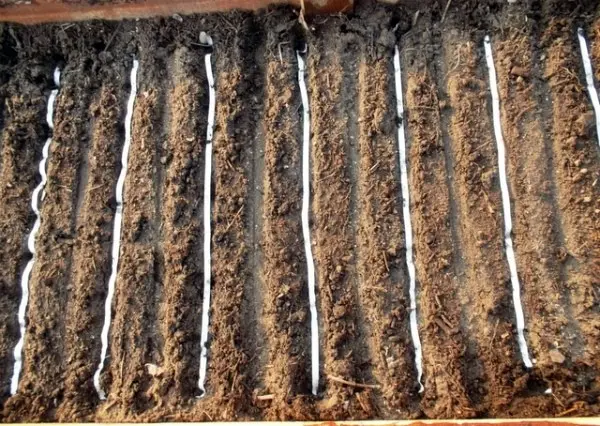
If radishes are planted in a polycarbonate greenhouse, then there is a need for more careful control over humidity and temperature, since polycarbonate structures heat up faster. This is very good for radishes grown in autumn and winter, but for spring radishes, too high a temperature is dangerous – the seedlings will stretch out and the roots will not form.
Peculiarities of growing
For the most successful cultivation of radishes in a greenhouse, two basic conditions must be observed: soil moisture and temperature. For the entire growing season of radishes, the temperature is adjusted several times. Within 2–3 days after the seeds are planted in the ground, the temperature is maintained at +15–18 °C. After germination, the degree is lowered to + 8–10 ° C so that young shoots do not stretch. When the tops grow back, the temperature is raised again to + 15–20 ° C – such conditions are necessary for the formation of root crops.

Since radishes need moist soil to grow, special attention is paid to watering. Until shoots appear, you need to water the radish daily, and then you can switch to the mode 1 time in 2-3 days. It is necessary to ensure that the soil does not dry out, since the root crops coarsen from a lack of moisture, and if the bed is watered abundantly after a drought, they will crack. After watering, the greenhouse should be ventilated – a high level of air humidity contributes to the development of fungal diseases. It is also necessary to ventilate the greenhouse at temperatures above + 20–22 ° C.
Daylight hours for radishes should be approximately 12 hours. If the culture has to be planted in winter, then you need to think about additional lighting. Also, when growing winter radishes, you should take care of heating the greenhouse. Feed the plants only if the soil is depleted by the continuous cultivation of early vegetables. Since greenhouse radishes are planted in the same soil as in the garden, it is not surprising that they sometimes get sick. To prevent fungal diseases, plants should be sprayed from time to time with a solution of ash and soap in the proportion of 1 cup of ash, 50 g of soap / 10 liters of water.
Video “Trick when planting radishes in a greenhouse”
This video will show you what a little trick you can use to plant radishes in a greenhouse conveniently and quickly.
Author: Svetlana Galitsina
Loading…









